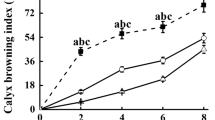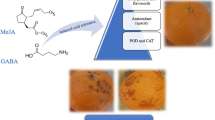Abstract
The effects of a combined treatment of hot air (HA, 38 °C for 6 h) and methyl jasmonate (MeJA, 16 μmol L−1) on chilling injury, fruit quality, and physiological changes in loquat fruit stored at 1 °C were investigated. The results showed that treatment with HA or MeJA alone both significantly alleviated chilling injury in loquat fruit compared with the control, while their combination had the lowest level of chilling injury symptoms and highest quality. The activities of antioxidant enzymes such as superoxide dismutase, ascorbate peroxidase, and catalase were enhanced by the combination of HA and MeJA. In addition, the combined treatment significantly inhibited the activities of phenylalanine ammonia-lyase, peroxidase, and polyphenol oxidase, which resulted in lower lignin content. Highest level of polygalacturonase activity and water-soluble pectin content and lowest level of protopectin content were also observed in the combined treatment. These results suggested that the enhanced chilling tolerance by combination of HA and MeJA treatment in loquat fruit was related to the induction of antioxidant enzymes and the inhibition of lignin biosynthesis. The combination of HA and MeJA treatment could be a useful technique to alleviate chilling injury and maintain quality of loquat fruit during cold storage.




Similar content being viewed by others
Abbreviations
- HA:
-
Hot air
- MeJA:
-
Methyl jasmonate
- CI:
-
Chilling injury
- IB:
-
Internal browning
- TSS:
-
Total soluble solid
- TA:
-
Titratable acidity
- SOD:
-
Superoxide dismutase
- APX:
-
Ascorbate peroxidase
- CAT:
-
Catalase
- PAL:
-
Phenylalanine ammonia-lyase
- POD:
-
Peroxidase
- PPO:
-
Polyphenol oxidase
- PG:
-
Polygalacturonase
- RSM:
-
Response surface methodology
References
Apel, K., & Hirt, H. (2004). Reactive oxygen species: metabolism, oxidative stress, and signal transduction. Annual Review of Plant Biology, 55, 373–399.
Assis, J. S., Maldonado, R., Muñoz, T., Escribano, M. I., & Merodio, C. (2001). Effect of high carbon dioxide concentration on PAL activity and phenolic contents in ripening cherimoya fruit. Postharvest Biology and Technology, 23, 33–39.
Boerjan, W., Ralph, J., & Buaeher, M. (2003). Lignin biosynihesis. Annual Review of Plant Physiology and Plant Molecular Biology, 54, 519–546.
Cai, C., Xu, C. J., Shan, L. L., Li, X., Zhou, C. H., Zhang, W. S., et al. (2006). Low temperature conditioning reduces postharvest chilling injury in loquat fruit. Postharvest Biology and Technology, 41, 252–259.
Cao, S. F., Zheng, Y. H., Yang, Z. F., Tang, S. S., Jin, P., Wang, K. T., et al. (2008). Effect of methyl jasmonate on inhibition of colletotrichum acutatum infection in loquat fruit and the possible mechanism. Postharvest Biology and Technology, 47, 151–158.
Cao, S., Zheng, Y., Wang, K., Rui, H., & Tang, S. (2009a). Effect of methyl jasmonate on cell wall modification of loquat fruit in relation to chilling injury after harvest. Food Chemistry, 118, 641–647.
Cao, S., Zheng, Y., Wang, K., Jin, P., & Rui, H. (2009b). Methyl jasmonate reduces chilling injury and enhances antioxidant enzyme activity in postharvest loquat fruit. Food Chemistry, 115, 1458–1463.
Cao, S., Zheng, Y., Wang, K., Rui, H. J., & Shang, H. T. (2010a). The effects of 1-methylcyclopropene treatment on chilling and cell wall metabolism in loquat fruit. The Journal of Horticultural Science and Biotechnology, 85, 147–153.
Cao, S., Hu, Z., Zheng, Y., & Hu, B. (2010b). Synergistic effect of heat treatment and salicylic acid on alleviating internal browning in cold-stored peach fruit. Postharvest Biology and Technology, 58, 93–97.
Chance, B., & Maehly, A. C. (1955). Assay of catalases and peroxidase. Methods in Enzymology, 2, 764–775.
Chen, J., He, L., Jiang, Y., Wang, Y., Joyce, D. C., Ji, Z., et al. (2008). Role of phenylalanine ammonia-lyase in heat pretreatment-induced chilling tolerance in banana fruit. Physiologia Plantarum, 132, 318–328.
Creelman, R. A., & Mullet, J. E. (1997). Biosynthesis and action of jasmonate in plants. Annual Review of Plant Physiology and Plant Moecular Biology, 488, 355–381.
Ding, C. K., Wang, C. Y., Gross, K. C., & Smith, D. L. (2001). Reduction of chilling injury and transcript accumulation of heat shock protein genes in tomatoes by MeJA and MeSA. Plant Science, 161, 1153–1159.
Duan, Y., Kong, F., Zhao, J., Shen, J., Wu, X., Jin, P., et al. (2011). Optimization of combined treatment condition of hot air and methyl jasmonate for postharvest loquat fruit preservation. Transactions of the Chinese Society of Agricultural Engineering, 27, 370–374.
González Aguilar, G. A., Buta, J. G., & Wang, C. Y. (2003). Methyl jasmonate and modified atmosphere packaging (MAP) reduce decay and maintain post harvest quality of papaya‘Sunrise’. Postharvest Biology and Technology, 28, 361–370.
Jin, P., Zheng, Y., Tang, S., Rui, H., & Wang, C. Y. (2009a). A combination of hot air and methyl jasmonate vapor treatment alleviates chilling injury of peach fruit. Postharvest Biology and Technology, 52, 24–29.
Jin, P., Wang, K., Shang, H., Tong, J., & Zheng, Y. (2009b). Low-temperature conditioning combined with methyljasmonate treatment reduces chilling injury of peach fruit. Journal of the Science of Food and Agriculture, 89, 1690–1696.
Jin, P., Shang, H., Chen, J., Zhu, H., Zhao, Y., & Zheng, Y. (2011). Effect of 1-methylcyclopropene on chilling injury and quality of peach fruit during cold storage. Journal of Food Science, 76, 5485–5491.
Kochba, J., Lavee, S., & Spiegel-Roy, P. (1977). Difference in peroxidase activity and isoenzymes in embryogenic and non-embryogenic ‘Shamouti’ orange ovular callus lines. Plant and Cell Physiology, 18, 463–467.
Lu, J., Charles, M. T., Vigneault, C., Goyette, B., & Raghavan, G. S. V. (2010). Effect of heat treatment uniformity on tomato ripening and chilling injury. Postharvest Biology and Technology, 56, 155–162.
Mirdehghan, S. H., Rahemi, M., Martínez-Romero, D., Guillen, F., Valverde, J. M., Zapata, P. J., et al. (2007). Reduction of pomegranate chilling injury during storage after heat treatment: role of polyamines. Postharvest Biology and Technology, 44, 19–25.
Murr, D. P., & Morris, L. L. (1974). Influence of O2 and CO2 on o-diphenol oxidase activity in mushrooms. Journal of the American Society for Horticultural Science, 99, 155–158.
Murray, R., Lucangeli, C., Polenta, G., & Budde, C. (2007). Combined prestorage heat treatment and controlled atmosphere storage reduced internal breakdown of ‘Flavorcrest’ peach. Postharvest Biology and Technology, 44, 116–121.
Nakano, Y., & Asada, K. (1989). Hydrogen peroxide is scavenged by ascorbate specific peroxidase in spinach chloroplasts. Plant Cell Physiology, 22, 867–880.
Patterson, B. D., Mackae, E. A., & Ferguson, I. B. (1984). Estimation of hydrogen peroxide in plant extracts using titanium. Analytical Biochemistry, 139, 487–492.
Rao, M. V., Paliyath, G., & Ormrod, D. P. (1996). Ultraviolet-B- and ozone-induced biochemical changes in antioxidant enzymes of Arabidopsis thaliana. Plant Physiology, 110, 125–136.
Rui, H. J., Wang, K. T., Shang, H. T., Tang, S. S., Jin, P., Cao, S. F., et al. (2009). Effects of heat treatment on flesh leatheriness and related enzyme activities of loquat fruits during cold storage. Transactions of the Chinese Society of Agricultural Engineering, 25, 294–298.
Rui, H. J., Cao, S. F., Shang, H. T., Jin, P., Wang, K. T., & Zheng, Y. H. (2010). Effects of heat treatment on internal browning and membrane fatty acid in loquat fruit in response to chilling stress. Journal of the Science of Food and Agriculture, 90, 1557–1561.
Sala, J. M. (1998). Involvement of oxidative stress in chilling injury in cold-stored mandarin fruits. Postharvest Biology and Technology, 13, 255–261.
Sun, J. H., Chen, J. Y., Kuang, J. F., Chen, W. X., & Lu, W. J. (2010). Expression of sHSP genes as affected by heat shock and cold acclimation in relation to chilling tolerance in plum fruit. Postharvest Biology and Technology, 55, 91–96.
Suzuki, N., & Mittler, R. (2006). Reactive oxygen species and temperature stresses: a delicate balance between signaling and destruction. Physiologia Plantarum, 126, 45–51.
Wang, K. T., Jin, P., Shang, H. T., Li, H. M., Xu, F., Hu, Q. H., et al. (2010). A combination of hot air treatment and nano-packing reduces fruit decay and maintains quality in postharvest Chinese bayberries. Journal of Agricultural and Food Chemistry, 90, 2427–2432.
Yang, Z., Cao, S., Zheng, Y., & Jiang, Y. (2012). Combined salicyclic acid and ultrasound treatments for reducing the chilling injury on peach fruit. Journal of Agricultural and Food Chemistry, 60, 1209–1212.
Zhang, X., Sheng, J., Li, F., Meng, D., & Shen, L. (2012). Methyl jasmonate alters arginine catabolism and improves postharvest chilling tolerance in cherry tomato fruit. Postharvest Biology and Technology, 64, 160–167.
Zheng, Y. H., Li, S. Y., & Xi, Y. F. (2000). Changes of cell wall substances in relation to flesh woodiness in cold-stored loquat fruits. Acta Phytophysiologica Sinica, 26, 306–310.
Zheng, Y. H., Raymond, W. M. F., Wang, S. Y., & Wang, C. Y. (2008). Transcript levels of antioxidative genes and oxygen radical scavenging enzyme activities in chilled zucchini squash in response to superatmospheric oxygen. Postharvest Biology and Technology, 47, 151–158.
Zhou, H. W., Dong, L., Ben-Arie, R., & Lurie, S. (2000). Pectin esterase, polygalacturonase and gel formation in peach pectin fractions. Phytochemistry, 55, 191–195.
Zhu, L. Q., Zhou, J., & Zhu, S. H. (2010). Effect of a combination of nitric oxide treatment and intermittent warming on prevention of chilling injury of ‘Feicheng’ peach fruit during storage. Food Chemistry, 212, 165–170.
Acknowledgments
This study was supported by the National Natural Science Foundation of China (31071616) and Special Fund for Agro-scientific Research in the Public Interest (201003073).
Author information
Authors and Affiliations
Corresponding author
Rights and permissions
About this article
Cite this article
Jin, P., Duan, Y., Wang, L. et al. Reducing Chilling Injury of Loquat Fruit by Combined Treatment with Hot Air and Methyl Jasmonate. Food Bioprocess Technol 7, 2259–2266 (2014). https://doi.org/10.1007/s11947-013-1232-3
Received:
Accepted:
Published:
Issue Date:
DOI: https://doi.org/10.1007/s11947-013-1232-3




